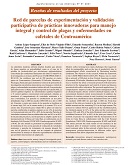| dc.contributor.author | López-Sampson, Arlene | |
| dc.contributor.author | Melo Virginio Filho, Elias de | |
| dc.contributor.author | Somarriba, Eduardo | |
| dc.contributor.author | Gamboa Morillo, Harold | |
| dc.contributor.author | Medina, Bayron | |
| dc.contributor.author | Marcucci, José Sebastián | |
| dc.contributor.author | Duarte, Marco Tulio | |
| dc.contributor.author | Funes, Omar | |
| dc.contributor.author | García, Calixto | |
| dc.contributor.author | Núñez, Carlos Rubén | |
| dc.date.accessioned | 2021-07-30T19:54:08Z | |
| dc.date.available | 2021-07-30T19:54:08Z | |
| dc.date.issued | 2021 | |
| dc.identifier.uri | https://repositorio.catie.ac.cr/handle/11554/11138 | |
| dc.description | 16 referencias, 5 tabulaciones, ilustrado, 4 tabulaciones, 17 páginas. | es_ES |
| dc.description.abstract | La caficultura moderna enfrenta muchos desafíos que afectan
de forma negativa su sostenibilidad, como es el caso de la
pérdida de productividad por afectaciones epidemiológicas
exacerbadas por condiciones fluctuantes del clima. El objetivo de
la investigación, en el marco del Proyecto CATIE-PROCAGICAIICA-
UE, fue establecer una red de 200 parcelas en cuatro
países de Centroamérica (Guatemala, El Salvador, Honduras y
Nicaragua, 50 por país), para monitorear el efecto de protocolos de
investigación con prácticas innovadoras en el manejo y control de
plagas y enfermedades asociadas al cultivo del café. Los protocolos
aplicados fueron: 1) Manejo integral mejorado del cafetal (MI), 2)
control químico-orgánico de enfermedades (químico-orgánico)
y 3) control químico convencional (convencional). Además, se
monitoreó el comportamiento de variedades resistentes a la
roya (variedades). Las parcelas se establecieron en tres pisos
altitudinales: bajo (<1000 m), medio (1000-1400 m) y alto (>1400
m). Cuarenta y cuatro por ciento de las parcelas se localizan en
el estrato bajo, 34% en el estrato medio y el restante 22% en el
estrato alto. El protocolo para validar MI se aplicó en todas las
parcelas establecidas, el químico-orgánico en un 14% de parcelas
y el convencional entre un 18% y 40% de las parcelas. Parcelas de
variedades resistentes fueron establecidas entre un 10% a un 40%
de las parcelas por país. La red de parcelas se amplió a partir de la
incorporación de 24 fincas en Costa Rica en colaboración con la
fundación Café Forestal, COOCAFE, Fundecooperación, ICAFE
y MAG. En este artículo se presentan los principales resultados
de incidencia de roya en las parcelas de evaluación de variedades
resistentes y parcelas de tratamiento de manejo integral. En
esta red de parcelas se cuenta con un conjunto de prácticas/
innovaciones de manejo en diferentes agroambientes cafetaleros
que permiten innovaciones de adaptación. | es_ES |
| dc.description.abstract | Modern coffee farming faces many challenges that negatively
affect its sustainability, such as the loss of productivity due to
epidemiological effects exacerbated by fluctuating weather
conditions. The objective of the research, within the framework
of the CATIE-PROCAGICA-IICA-EU Project, was to establish
a network of 200 plots in four Central American countries
(Guatemala, El Salvador, Honduras and Nicaragua, 50 per country),
to monitor the effect of research protocols with innovative
practices in the management and control of pests and diseases
associated with coffee cultivation. The protocols applied were: 1)
Comprehensive improved coffee plantation management (MI),
2) chemical-organic disease control (chemical-organic) and 3)
conventional chemical control (conventional). In addition, the
behavior of varieties resistant to rust (varieties) was monitored.
The plots were established in three altitudinal floors: low (<1000
m), medium (1000-1400 m) and high (>1400 m). Forty-four
percent of the plots are located in the low stratum, 34% in the
middle stratum and the remaining 22% in the high stratum. The
protocol to validate MI was applied in all the established plots,
the chemical-organic in 14% of the plots and the conventional
between 18% and 40% of the plots. Resistant variety plots were
established between 10% to 40% of the plots per country. The
network of parcels was expanded with the incorporation of 24
farms in Costa Rica in collaboration with the Café Forestal
Foundation, COOCAFE, Fundecooperación, ICAFE and MAG.
This article presents the main results of rust incidence in the
evaluation plots of resistant varieties and integrated management
treatment plots. In this network of plots there is a set of
management practices/innovations in different coffee agroenvironments
that allow adaptation innovations. | |
| dc.language.iso | es | es_ES |
| dc.publisher | CATIE, Turrialba (Costa Rica) | es_ES |
| dc.relation.ispartof | Agroforestería en las Américas Número 51 (2021), páginas 67-83 | |
| dc.rights | info:eu-repo/semantics/openAccess | es_ES |
| dc.subject | CONTROL DE PLAGAS | es_ES |
| dc.subject | INNOVACION | es_ES |
| dc.subject | PLAGAS NOCIVAS | es_ES |
| dc.subject | PLAGAS DE PLANTAS | es_ES |
| dc.subject | PLAGAS | es_ES |
| dc.subject | SOSTENIBILIDAD | es_ES |
| dc.subject | PROYECTOS DE INVESTIGACION | es_ES |
| dc.subject | PARCELA | es_ES |
| dc.subject | MANEJO FORESTAL | es_ES |
| dc.title | Red de parcelas de experimentación y validación participativa de prácticas innovadoras para manejo integral y control de plagas y enfermedades en cafetales de Centroamérica | es_ES |
| dc.type | Artículo | es_ES |
| dc.journal.issueNumber | 51 | |


